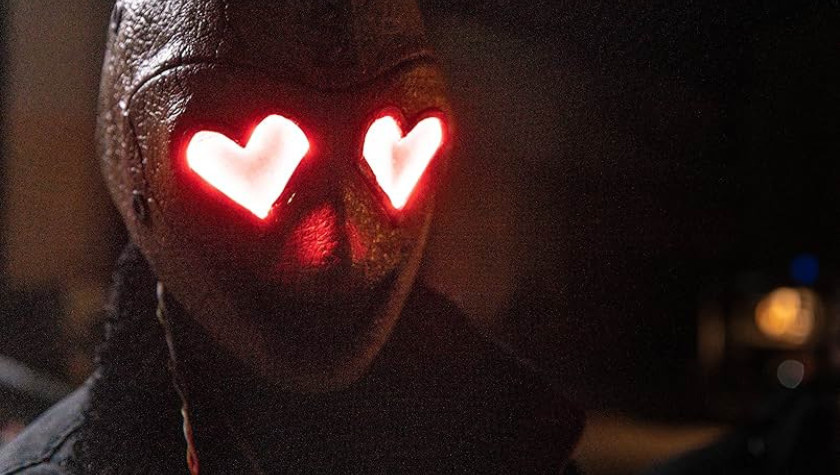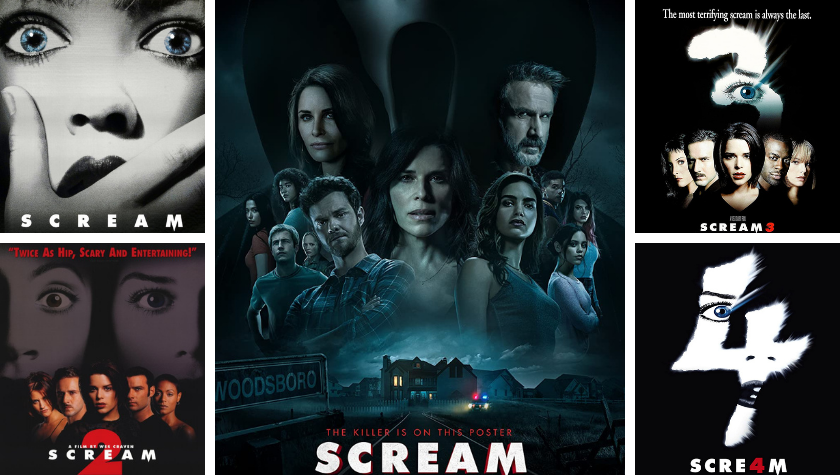‘Take 5’ How Scream 6 keeps a horror film franchise fresh
March 13, 2023
In the month of March 2023, franchise sequels are abundant: Creed III, John Wick 4 and Scream VI. Between sports dramas, action and horror, each franchise has its own set of rules and tropes. The Scream franchise is a compelling study because of the built-in self-awareness it flaunts. This is how writer Kevin Williamson set up the original Scream film in 1996, which included rules for surviving a slasher film and playing off the expected tropes of the genre.
Last year’s Scream, which didn’t have a number succeeding the title, was a “requel” – a sequel that is also a reboot of a franchise. Scream VI is the sequel to the reboot and so it has its own rules that the characters must abide by and accept including anyone in the requel film including the leads and any of the original characters can die — Scream is notorious for having a film-geek character explain the rules of the respective film.
How does the fifth sequel in a 27-year-old film franchise remain fresh and original? And what can writers take away from Scream VI?
- A fresh, new location
Half of the Scream films have taken place in the small town of Woodsboro. Scream 2 took the story to college and the third one to Hollywood. What makes the new location a compelling idea to play on is that it’s New York City, a place that is crowded, cramped and constructed so that people live in close proximity. Ghostface doesn’t attack in suburban houses, but rather in apartments, subway cars, alleys and bodegas.
The reason for the location shift is that the survivors of Scream are now in college and Tara (Jenna Ortega), Mindy (Jasmin Savoy Brown) and Chad (Mason Gooding) have decided to stick together. Tara’s sister Sam (Melissa Barrera) has followed her sibling because she wants to be the protector. The reasons are valid pushing the franchise into new and fresh territory while opening the door for more creative killing. It also provides legitimate opportunity for new character introductions without it seeming forced.
Screenwriters can see how changing up a location can benefit the next chapter of a story and keep a sequel feeling original.
- Franchise and Genre Tropes
How does each Scream film start? With a ringing phone, the killer luring the victim out and a gruesome murder. So, why would this one be any different? This is a trope for the Scream franchise, one that organically came about and doesn’t necessarily have anything to do with the horror genre. The important lesson here is that the stories you create may have tropes themselves that you should recognize and exploit if you’re writing sequels or additional stories in your own series.
There are also genre tropes that you must recognize. Even if you don’t use these tropes, it’s imperative to know what they are because audiences have a subconscious expectation when they engage in a genre story. For horror, the tropes can be anything from the jump scare, one last attack from the villain and how the intended victim flees into a room and tries to close/lock the door.
Make sure you learn about the tropes in the genre you’re writing and consider why it’s effective. They can enhance your story and open it up to new ideas.
- Two Competing Forces
It’s not enough to throw people into a situation where they have to run from a killer, there must be conflict amongst the group.
In Scream VI, part of the conflict stems from Sam and Tara whose history had been established in the previous film. Sam wasn’t around much but, as Ghostface reappeared in Woodsboro, she showed up and helped her sister survive.
This sequel expands on the sibling dynamic. Sam has become over-protective of her younger sister butting into her personal life, always insisting she answers calls and texts quickly and even preventing her from hooking up with someone at a party.
Tara is the opposite. She would rather forget what happened in Woodsboro and focus on fun and future; she wants the college life. She finds safety in the crowds of the city and wants to live her life as she sees fit.
This setup builds the arc of how the characters will change throughout the story. Obviously the question becomes, How will Sara learn to let go and how will Tara accept that she must deal with her past responsibly?
This all takes place in the context of people getting slashed and murdered. Even in slasher films, characters can’t be shallow victims but more complex people dealing with complicated lives.
- What Came Before It?
Entertainment is filled with nostalgia. While movies and TV shows are introducing rebooted versions of previously popular entertainment, the old viewers who grew up enjoying it appreciate seeing the original characters.
Corba Kai has embraced this model often bringing back old characters from the movies and helping rehash old rivalries. Look at Spider-Man: No Way Home and how they placed the previous Peter Parkers into the same universe. The Flash is bringing back Michael Keaton as Batman.
Reboots are no longer starting over from scratch. In Scream VI, Kirby (Hayden Panttierre) who appeared in the fourth film returns as an FBI agent, Gale Weathers (Courteney Cox) has been a staple throughout the entire franchise and Billy Loomis (Skeet Ulrich) is the father of Sam. This is a connection for older audiences while also guiding the new story.
Writers can see how films like Scream franchise play on nostalgia to entice and delight audiences. Using nostalgia helps connect your characters with the audience. In the first Scream, the references of older slasher audiences are one of the reasons it resonated with fans of the genre at the time.
- Who Dun It?
Scream is essentially a ‘Who Dun It’ mystery. The cloaked villain never reveals their identity until the end and keeps everyone guessing. Anyone could be the killer and the audience becomes invested in trying to figure out the mystery amid twists, turns and red herrings. The Scream franchise adds another layer though because from the very first movie it offered the idea that there may not be one killer, but multiple murderers.
This type of slasher movie differs from the monster concept. We know that Freddy Kreuger and Michael Myers are the villains in their respective franchises but Scream is a mystery. If you’re looking to create a murder mystery, Scream is worth taking a look at from that perspective. What clues are dropped? What do the characters say and do that manipulate the narrative? And, when all is revealed, how did the person/people act from the beginning?
Glass Onion is a light-hearted, comedic murder mystery. Scream VI is a horror murder mystery. Both offer ways to incorporate a multi-genre approach to telling a story as a "Who Dun It."
Scream has been able to tell and retell their Ghostface story while maintaining a semblance of originality in each one. Scream VI continues the franchise in a fresh new way and offers screenwriters plenty to consider if they’re writing their own horror, mystery or even action films.
Scream VI is currently in theaters. The film was written by James Vanderbilt & Guy Busick based on characters created by Kevin Williamson, and was directed by Matt Bettinelli-Olpin and Tyler Gillett.
Written by: Steven Hartman
Steven Hartman is an award-winning, optioned screenwriter. He was a Top 5 Finalist in Big Break’s Historical Category in 2019 and won Best Action/Adventure in Script Summit’s Screenplay Competition in 2021. He holds a Bachelor of Arts degree from Columbia College and had internships at Jerry Bruckheimer Films and Village Roadshow Pictures. Steve is a full-time writer and creative video producer by day and a screenwriter and novelist by night.- Topics:
- Screenwriting & Craft




